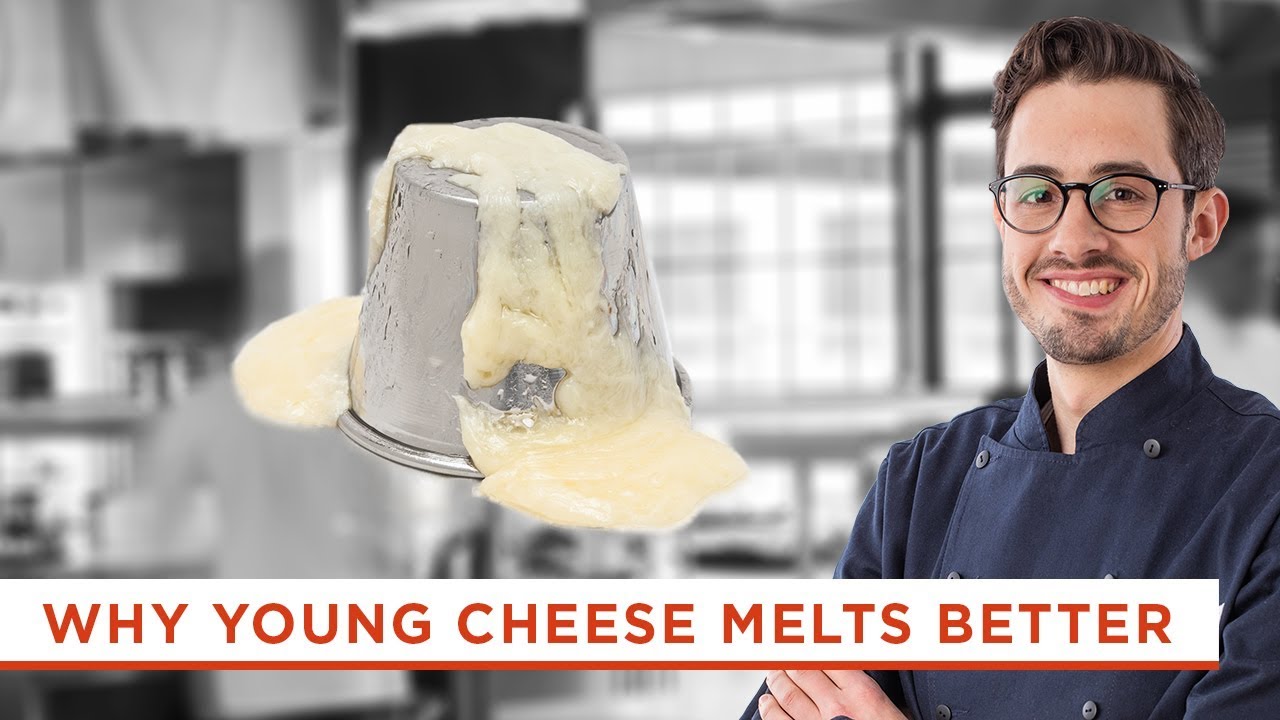Click here for more kitchen tips:
Watch our Equipment Reviews:
EXPERIMENT: We purchased Cabot Creamery cheddars aged for three, 16, and 24 months (all were sealed against evaporation during aging) and baked slices from each block on top of inverted metal cups that we preheated in a 175-degree oven until each slice had melted.
RESULTS: The three-month-old cheddar melted smoothly, evenly flowing down the cup’s sides. Meanwhile, the 16-month-old cheddar showed signs of clumping as it slid down the metal, and the 24-month-old cheese actually broke into two large pieces and never melted.
EXPLANATION: Moisture plays a part in how cheese melts, but the state of its protein—specifically, its network of casein protein—affects it most. In freshly made cheeses, casein proteins are in tightly wound clusters, allowing for little interaction with one another. As cheese ages, it goes through a process called proteolysis, in which bonds between individual casein molecules are “snipped,” allowing the clusters to unwind and bind with other casein molecules, forming a matrix. Early in this process, the matrix is flexible, allowing young cheeses to melt smoothly. With time, the proteins bond together tighter, forming a stronger network that requires more heat to melt and is less flexible when melted. This can result in more separated fat and clumps, as with our older samples.
ABOUT US: Located in Boston’s Seaport District in the historic Innovation and Design Building, America’s Test Kitchen features 15,000 square feet of kitchen space including multiple photography and video studios. It is the home of Cook’s Illustrated magazine and Cook’s Country magazine and is the workday destination for more than 60 test cooks, editors, and cookware specialists. Our mission is to test recipes over and over again until we understand how and why they work and until we arrive at the best version.
If you like us, follow us:
Related posts
17 Comments
Leave a Reply Cancel reply
You must be logged in to post a comment.


I tried to make pasta with Sargento cheese I swear I thought it was plastic
I wondered why … thank you.
wow he's hot
Umm trying to simply something but instead make it over complicated. I was better off before watching this amylose fest.
My winning strategy with cheese is that More=Better.
and there you have it. is there a particularly way i should cut the cheese?
You are officially my Favourite Top World Ranking Chef Dan!!!
I cannot cook for the life of me following other chefs…. since I need to understand what I'm doing to confidently and successfully go ahead and do it.
You give the understanding behind the cooking.
Love to you and your team!!
The text slide is distracting. A quick fade in would work better.
Is it just me or did Dan look especially delicious in this video? 😋
Does it matter if you use potato starch instead of corn starch?
Sodium Citrate?
That is something I didn't know about the cheeses and maybe why I have gotten bad results with some cheeses.
Great information. I never thought about how cheese melts compared to age, but makes a lot of sense.
What about adding Sodium Citrate? I thought that was one of the main solutions for smooth, no split cheese melting.
👍Thanks for providing the proportions of aged to moist cheese depending on use. I've been avoiding making Mac & cheese because it's been either bland or greasy. I'll give it another go with a 50/50 mix. Thanks again
I don't know if it was because of the amount of water or the starchiness of the particular pasta, but I once tried to cook some Ronzoni Spaghetti in a smaller amount of water and the whole thing turned into wallpaper paste. It was amazing how much starch was there. I haven't used Ronzoni products since.
"Depending on what you're making, there are important factors to look for when choosing the best cheeses to use."
This video didn't really explore this very much; it was more about what to add to whichever aged cheese one selects to get it to melt well. To which I'll add another: adding a bit of wine, beer, cider, etc. can help keep fondue from breaking down, while adding a bit of brightness to the mix.
Those words across the bottom drive me nuts. Is it a video I am watching or an article I am reading?